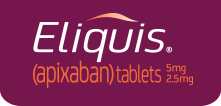

ELIQUIS is the #1 prescribed oral anticoagulant among cardiologists1*
Dosing for reduction in risk of stroke/systemic embolism in adult patients with nonvalvular atrial fibrillation (NVAF)
ELIQUIS dosing in NVAF
Recommended dose for most NVAF patients2:
5 mg twice daily

In 2 phase III NVAF clinical trials, approximately 95% of ELIQUIS patients received this dose2-4
Dosage adjustment2:
2.5 mg twice daily
Recommended dose for: Patients with at least 2 of the following
age≥80 years
body weight≤60 kg
serum creatinine≥1.5 mg/dL
Please see drug interactions below for coadministration with combined P-gp and strong CYP3A4 inhibitors.
No food restrictions or meal requirements—food does not affect the bioavailability of ELIQUIS
No international normalized ratio (INR) monitoring
No special storage requirements
The half-life of ELIQUIS is approximately 12 hours following oral administration
Patients with end-stage renal disease (ESRD) on dialysis:
- Clinical efficacy and safety studies with ELIQUIS did not enroll patients with ESRD on dialysis
- In patients with ESRD maintained on intermittent hemodialysis, administration of ELIQUIS at the usually recommended dose will result in concentrations of apixaban and pharmacodynamic activity similar to those observed in the ARISTOTLE study
- It is not known whether these concentrations will lead to similar stroke reduction and bleeding risk in patients with ESRD on dialysis as were seen in ARISTOTLE
Drug interactions
| Drug categories/examples2 | Key considerations2 |
|---|---|
Drugs affecting hemostasis
|
Coadministration with these drugs increases the risk of bleeding. |
Combined P-gp and strong CYP3A4 inhibitors
|
Reduce dose by 50%: For patients receiving ELIQUIS doses of 5 mg or 10 mg twice daily when coadministered with combined P-gp and strong CYP3A4 inhibitors. In patients already taking ELIQUIS at a dose of 2.5 mg twice daily: Avoid coadministration with combined P-gp and strong CYP3A4 inhibitors. These drugs increase exposure to ELIQUIS and increase the risk of bleeding. |
|
Pharmacokinetic data suggest that no dose adjustment is necessary. |
Combined P-gp and strong CYP3A4 inducers
|
Avoid concomitant use. These drugs decrease exposure to ELIQUIS and increase the risk of stroke and other thromboembolic events. |
- Apixaban is a substrate of both CYP3A4 and P-gp
- Famotidine, atenolol, prasugrel, and enoxaparin did not meaningfully alter the pharmacokinetics of ELIQUIS in healthy subjects
- ELIQUIS did not meaningfully alter the pharmacokinetics of digoxin, naproxen, atenolol, prasugrel, or acetylsalicylic acid in healthy subjects
- APPRAISE-2, a placebo-controlled clinical trial of apixaban in high-risk post-acute coronary syndrome patients treated with aspirin or the combination of aspirin and clopidogrel, was terminated early due to a higher rate of bleeding with apixaban compared with placebo
- For diltiazem, no dose adjustment of ELIQUIS is required53
This chart contains examples of drugs in each of the categories described. These examples reflect those in the ELIQUIS Full Prescribing Information, but do not represent an all-inclusive list.
Missed dose
If a dose of ELIQUIS is not taken at the scheduled time, the dose should be taken as soon as possible on the same day and twice-daily administration should be resumed. The dose should not be doubled to make up for a missed dose.2
Temporary interruption for surgery and other interventions
| Bleeding risk with elective surgery or invasive procedures | Recommendation2 |
|---|---|
| Moderate or high risk of unacceptable or clinically significant bleeding | Discontinue ELIQUIS at least 48 hours prior. |
| Low risk or noncritical site and easily controlled | Discontinue ELIQUIS at least 24 hours prior. |
- Bridging anticoagulation during the 24 to 48 hours after stopping ELIQUIS and prior to the intervention is not generally required. ELIQUIS should be restarted after surgical or other procedures as soon as adequate hemostasis has been established
Guidance for switching to and from ELIQUIS
| Patients switching from |
Recommendation2 |
|---|---|
| Warfarin to ELIQUIS | Discontinue warfarin and start ELIQUIS when international normalized ratio (INR) is <2.0. |
| Anticoagulants other than warfarin (oral or parenteral) to ELIQUIS | Discontinue the anticoagulant other than warfarin and begin taking ELIQUIS at the usual time of the next dose of the anticoagulant other than warfarin. |
| ELIQUIS to anticoagulants other than warfarin (oral or parenteral) | Discontinue ELIQUIS and begin taking the new anticoagulant other than warfarin at the usual time of the next dose of ELIQUIS. |
| ELIQUIS to warfarin | ELIQUIS affects INR, so that initial INR measurements during transition to warfarin may not be useful for determining appropriate dose of warfarin. One approach is to discontinue ELIQUIS and begin both parenteral anticoagulant and warfarin at the time the next dose of ELIQUIS would have been taken, discontinuing the parenteral anticoagulant when INR reaches an acceptable range. |
Administration options
- For patients who are unable to swallow whole tablets, 5 mg and 2.5 mg ELIQUIS tablets may be crushed and suspended in water, 5% dextrose in water (D5W), or apple juice, or mixed with applesauce and promptly administered orally
- Alternatively, ELIQUIS tablets may be crushed and suspended in 60 mL of water or D5W and promptly delivered through a 12 French nasogastric tube. Following administration of the dose, the nasogastric tube should be flushed with an additional 20 mL of water or D5W.
- Crushed ELIQUIS tablets are stable in water, D5W, apple juice, and applesauce for up to 4 hours
Dosing in patients with renal or hepatic impairment
Dosing considerations in patients with renal impairment2
Dosing considerations in NVAF patients with renal impairment2
No dose adjustment is recommended for patients with renal impairment, including those with end-stage renal disease (ESRD) on dialysis for the treatment of DVT, PE and reduction in the risk of recurrent DVT and PE following initial therapy
No dose adjustment is recommended for patients with renal impairment, including those with end-stage renal disease (ESRD) on dialysis for prophylaxis of DVT, which may lead to PE, following hip or knee replacement surgery
Clinical efficacy and safety studies with ELIQUIS did not enroll patients with ESRD on dialysis or patients with a creatinine clearance (CrCl) <15 mL/min; therefore, dosing recommendations are based on pharmacokinetic and pharmacodynamic anti-factor Xa (FXa) activity data in subjects with ESRD maintained on dialysis.
ELIQUIS elimination2
Renal excretion accounts for about 27% of total clearance.
ELIQUIS is eliminated in both urine and feces. Biliary and direct intestinal excretion contributes to elimination of ELIQUIS in the feces.
| No dose adjustment for renal impairment alone in patients with NVAF | ||||
|---|---|---|---|---|
 MILD MILD MODERATE MODERATE SEVERE SEVEREPatients with end-stage renal disease (ESRD) on dialysis:
|
Reduced dosing for renal impairment plus additional criteria |
Recommended dose for: age≥80 years body weight≤60 kg serum creatinine≥1.5 mg/dL |
ELIQUIS elimination |
Renal excretion
accounts for about 27% of total clearance ELIQUIS is eliminated in both urine and feces. Biliary and direct intestinal excretion contributes to elimination of ELIQUIS in the feces |
See Drug Interactions above for coadministration with combined P-gp and strong CYP3A4 inhibitors.
Dosing in patients with hepatic impairment
|
MILD
hepatic impairment (Child-Pugh class A) |
No dose adjustment required.2 |
|
MODERATE
hepatic impairment (Child-Pugh class B) |
There is limited clinical experience with ELIQUIS in patients with moderate hepatic impairment; dosing recommendation cannot be provided.2 |
|
SEVERE
hepatic impairment (Child-Pugh class C) |
ELIQUIS is not recommended.2 |
Adjust ELIQUIS dose for patients taking drugs that are combined P-gp and strong CYP3A4 inhibitors.
See Drug Interactions above for more information.
See Drug Interactions above for more information.
ELIQUIS: considerations for reversing the anticoagulant effects2
An agent to reverse the anti-factor Xa activity of ELIQUIS is available for adults
- Please visit www.andexxa.com for more information on availability of a reversal agent
The pharmacodynamic effect of ELIQUIS can be expected to persist for at least 24 hours after the last dose, ie, for about two drug half lives
Additional information for reversal of anticoagulant effect
- Prothrombin complex concentrate (PCC), activated prothrombin concentrate or recombinant factor VIIa may be considered but have not been evaluated in clinical studies
- When PCCs are used, monitoring for the anticoagulation effect of ELIQUIS using a clotting test (PT, INR, or aPTT) or anti-factor Xa (FXa) activity is not useful and is not recommended
- Hemodialysis does not appear to have a substantial impact on ELIQUIS exposure
- Protamine sulfate and vitamin K are not expected to affect the anticoagulant activity of ELIQUIS
- There is no experience with antifibrinolytic agents (tranexamic acid, aminocaproic acid) in individuals receiving ELIQUIS
- There is no experience with systemic hemostatics (desmopressin) in individuals receiving ELIQUIS, and they are not expected to be effective as a reversal agent
Activated oral charcoal reduces absorption of ELIQUIS, thereby lowering ELIQUIS plasma concentration
aPTT=activated partial thromboplastin time; INR=international normalized ratio; PT=prothrombin time.
Dosing in patients receiving combined P-gp and strong CYP3A4 inhibitors or combined P-gp and strong CYP3A4 inducers
Combined P-gp and strong CYP3A4 inhibitors
Reduce dose by 50%: For patients receiving ELIQUIS doses of 5 mg or 10 mg twice daily, when ELIQUIS is coadministered with drugs that are combined P-gp and strong CYP3A4 inhibitors (e.g., ketoconazole, itraconazole, or ritonavir).
Clarithromycin
Although clarithromycin is a combined P-gp and strong CYP3A4 inhibitor, pharmacokinetic data suggest that no dose adjustment is necessary with concomitant administration with ELIQUIS.
In patients already taking ELIQUIS at a dose of 2.5 mg twice daily: Avoid coadministration with combined P-gp and strong CYP3A4 inhibitors.
Combined P-gp and strong CYP3A4 Inducers
Avoid concomitant use of ELIQUIS with strong dual inducers of CYP3A4 and P-gp (e.g., rifampin, carbamazepine, phenytoin, St. John’s wort) because such drugs will decrease exposure to ELIQUIS and increase the risk of stroke and other thromboembolic events.
References
- Data on File: ELQ Market Share. Bristol-Myers Squibb Company, Princeton, NJ.
- ELIQUIS® (apixaban) Package Insert. Bristol-Myers Squibb Company, Princeton, NJ, and Pfizer Inc, New York, NY.
- Connolly SJ, Eikelboom J, Joyner C, et al. Apixaban in patients with atrial fibrillation. N Engl J Med. 2011;364(9):806-817.
- Granger CB, Alexander JH, McMurray JJV, et al; for the ARISTOTLE Committees and Investigators. Apixaban versus warfarin in patients with atrial fibrillation. N Engl J Med. 2011;365(11):981-992.
- Data on File. APIX075. Bristol-Myers Squibb Company, Princeton, NJ.




